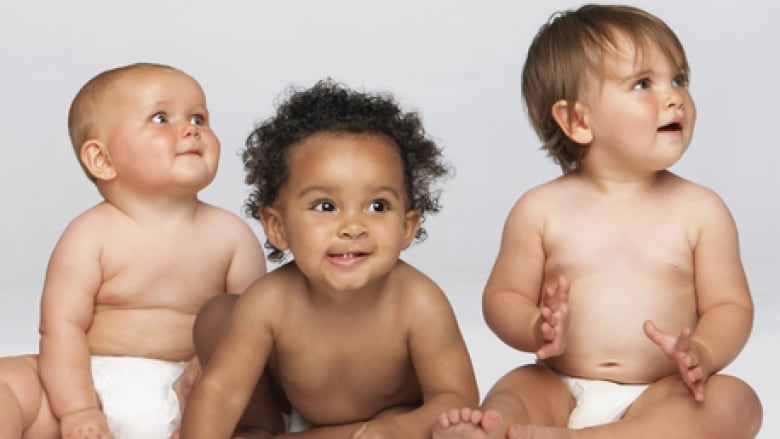Do babies show bias? Researchers seek the roots of racism
By 6 months, some 'attach negativity to people they're not familiar with,' scientist says

Is your brain racist?
The answer may not besimple.
For decades, sociologists and scientists have been studying racism and racial bias. And it turns out, human brains may be at the root.
There are two types of bias: explicit, which is obvious,and implicit, where preconceived ideasof which people are unawareinfluence their behaviour.
- Anti-black racism lives in Canada:Desmond Cole
- Family speaks out after 'N--ga lover' spray-painted
- Police must acknowledge bias:Indigenous advocates
While people may hold the steadfast belief that they aren't racist, it's stilllikely they exhibit implicit bias.
There have been many examples of how racial bias creeps into everyday life, from hiring practices to police actionstobasketball.
There's even a test for it, the Implicit Association Test. Developed by researchers at Harvard University, it measures people's automatic associations between concepts and evaluations.
The test measures responses when sorting black and white faces while connecting them with words. The key is hesitation. A person may try to associate good with a particular race, but it might take themlonger to respond, a sign that subconsciously, a person's brain associates unpleasantness with a particular race.
Babies' brains
So when do people begin to exhibit signs of racial bias? Some studies suggest it begins when babies are mere months old.
Kang Lee, a developmental neuroscientist who studies social cognition and behaviour at the University of Toronto, has done several studies on racial bias.
They don't attach negativity to people they're not familiar with. But by six months of age they start to do that.Kang Lee, University of Toronto
Most recently, Leepublished two studies in the journal Child Development. One study suggested that racial bias may be present in babies between six and nine months old.
The study concluded that between these ages, babies begin to associatefaces from their race with pleasant music and faces from other races withsad music.
"Basically, at three months of age, they like to look at things that arefamiliar, like food," Kang said. They like familiar formula or prefer to hear their mother's voice over someone else's.
"This is purely experiential and based on perception cues," he siad. "But there is no bias; they don't attach negativity to people they're not familiar with. But by six months of age they start to do that."
In his second study, Lee concludedthat babies are more likely to learn faster from people of their own race than from others.
The tendency to prefer own-race faces, or associate them with pleasant experiences, may be left over from early humanevolution, Lee said. Beforeglobalization, humans existedin more homogenous societies. They rarely encountered those from other races, and when they did, often they'd battle over food or territory.
Another researcher disagrees
But not everyone agrees that children so young exhibit racial bias. Andrew Baron, an associate professor in the department of psychology at the University of British Columbia, has also extensivelystudied bias. He doesn't believe children just months old are necessarily exhibiting racial bias.
Many of the tests for babies, including Lee's, measures the time a baby looks at an individual. But Baron says that's not a fair measure.
"They look at things they like," Baron said. "Total looking time doesn't tell you what they're thinking. In [Lee's] study, they reported longer looking time, but there's no reason to think that longer is due to race."
Instead, they could be looking longer because anobject is new to them, he said.
"My take is that it could be that own race is paired with positive," Baron said. "But they could be looking at other race because it's new and strange;there could be other interpretations."
Reversing the process
Children's apparentpreferences forthose of their own racedon't necessarily last, and they don't mean the babies will become racist.
But there are ways to limit racial bias in children.
"Introduce kids to have experiences with other-raceindividuals, either face-to-face or with media," Lee suggests.Parents could also avoid labelling people by race.

It's tricky;People may want to celebrate diversity by highlighting other cultures. However, this just makes children categorize people bygroups, Lee said.
For example, Singapore, which is highly diverse, celebrates Racial Harmony Daywhen, among other activities, schoolchildren are encouraged to wear traditional costumes.
Lee saidhis studiesfound that before children encounter this day at school, many didn't see other-race kids as different. But afterward, they tended to make distinctions.
"We can't get to a place where kids aren't racially biased, because we tend to use these labels all the time," he said.
There may be an argumentthat people should celebrate differences. Baron said that may just mean teaching them that other-race individuals have positive associations just as their own race does.
An article in Psychology Today suggests several ways adults can change their behaviour once they recognize their own racial bias. They can contrast negative stereotypes with examples that challenge their biases,try to see a situation or the world fromthe other person's perspectiveand engage in positive interactions with other racial groups.
And while all people may harbour some sort of racial bias, Lee says,"Bias does not necessarily translate into discrimination."












_(720p).jpg)


 OFFICIAL HD MUSIC VIDEO.jpg)
.jpg)



























































































